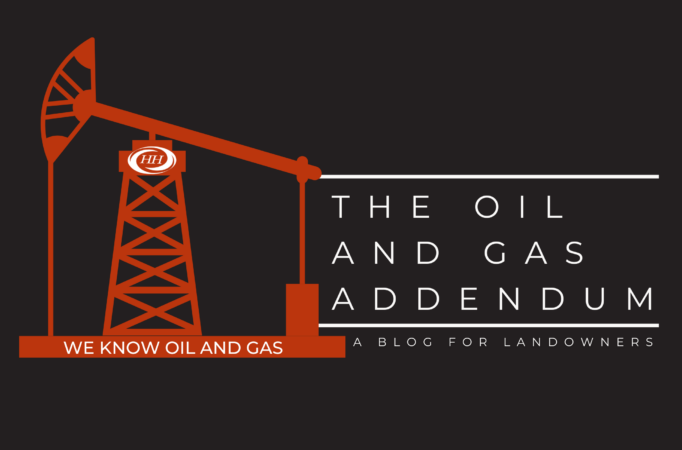The Oil and Gas Addendum
Hordis v. Cabot Oil and Gas Corporation: Landowner Challenges Whether Driller Can Ignore Pooling Clause and Simply Rely on Act 85
Oil and gas law is replete with unique terms and concepts. Perhaps one of the most confusing and complex areas of oil and gas law is the concept of “pooling”. Simply stated, pooling is the mechanism by which a driller aggregates multiple leases into a single production unit. Because modern horizontal wells can be over 7,000 feet, a driller needs to combine many individual leases to facilitate such development. A horizontal wellbore cannot pass underneath a parcel unless the driller has a lease with the owner of that parcel. As a result, the driller will form a production unit with thirty (30) to sometimes up to fifty (50) individual leases and each lease will share in the overall production from the unit. Each individual lease’s “share” is based on how much acreage that lease contributed to the overall unit. In other words, if the unit is 600 acres and Landowner X contributed 60 acres to the unit, his “share” of the production will be ten percent (10%).
Because pooling can and will impact the royalty clause in each individual lease, the right to pool must be expressly granted in the underlying lease. See, Southeastern Pipe Line Co. v. Tichacek, 997 S.W. 2d 170 (Tex. 1999) (“[A] lessee has no power to pool without the lessor’s express written authorization, usually contained in the lessee’s pooling clause”). As such, almost every modern oil and gas lease in the Marcellus region contains a pooling clause which delineates the scope and nature of the pooling rights granted to the lessee. A typical pooling clause will state that Landowner X “agrees to accept and receive out of the production or the revenue realized from production of such unit, such proportional share of the Royalty from each unit well as the number of Leased Premises acres included in the unit bears to the total number of acres in the unit”. Implicit in these clauses is a recognition and understanding that the unit wells will be located within the unit and that production from the unit wells will be shared only with Landowner X and those other leaseholders actually pooled into the unit. Many of these pooling clauses also stipulate that the unit itself cannot exceed certain size limitations (i.e., 640 acres). This limitation safeguards the landowner from unnecessary and harmful royalty dilution. These well-established principles may now be eroding here in Pennsylvania. In 2019, the Pennsylvania General Assembly enacted Act 85 which authorizes and allows drillers to ignore the express terms of a pooling clause and drill wells that cross unit boundaries. The authors submit that the recent case of Hordis v. Cabot Oil & Gas Corporation, where the landowner is contesting and disputing the driller’s authority to drill cross-unit wells, may be the first of many such lawsuits in Pennsylvania.
Act 85 and Cross-Unit Drilling
Before we examine the Hordis case, a brief review of Act 85 is warranted. On November 7, 2019, Governor Wolf signed Act 85 into law. The text of Act 85 consists of only two pages. But, the impact will be significant and far reaching.
The principal impact of Act 85 is that it authorizes and allows a driller to drill unconventional wells (i.e., Marcellus and Utica wells) horizontally across and through unit boundaries. In other words, a single horizontal wellbore may now hold and maintain leases which are in two completely different units. At first glance, this might not seem like that big of a deal. However, as discussed above, under existing Pennsylvania law, a horizontal well must generally remain within the footprint of a single unit. This is because most pooling clauses in the Marcellus region contain an express formula by which the production royalty will be calculated if the leasehold is pooled. These clauses and the royalty formulas set forth therein will be essentially re-written and altered by Act 85.
The new statutory authority set forth in Act 85 is subject to two (2) conditions which must be satisfied before the driller can drill a cross-unit well:
- the operator must have the right to drill a well “on separate units” in the first place in order to drill across unit boundaries; and
- the operator cannot drill across unit boundaries if doing so is “expressly prohibited by the terms of a lease.”
If a driller has the right to drill horizontal wells on separate units and cross-unit drilling is not expressly prohibited by a lease, then Act 85 ostensibly allows a driller to drill a horizontal wellbore that may cross from one unit into another. The author submits that an argument could be made that many pooling clauses in existing leases may trigger the prohibition set forth in subsection two (2) above. Unless the driller complies with the royalty formula set forth in the underlying pooling clause, the purported multi-unit well may not be authorized under Act 85. The statute itself, however, is unclear on what constitutes an express prohibition and, therefore, this question will have to be resolved by Pennsylvania courts.
Of course, if an operator drills wells across unit boundaries, a question arises about how the volume of hydrocarbons that enters the wellbore will be allocated among the two geographic areas that the well traverses. To this end, Act 85 states that the driller must “reasonably allocate[] production from the well to or among each unit the operator reasonably determines to be attributable to each unit.” The authors submit that this language is alarmingly vague and open-ended. Again, the statute does not define what is meant by “reasonably determines”. Nor does the statute define when such a determination must be made by the driller. Finally, the statute does not identify what factors must be taken into account by the driller when evaluating how to allocate production between the two units. This last omission is especially troubling. The drafters could have used a formula that allocates production between the two units based on the linear length of the wellbore in each unit. Or they could have simply required that the landowner’s royalty be based on the actual volume of hydrocarbons produced by the particular unit. Either approach would have provided an objective and uniform metric that would govern production allocation. The absence of any such clear guidelines is inexcusable and a recipe for disaster.
The Hordis case and Cross-Unit Drilling
At issue in Hordis is a 2007 Lease involving a 194 acre parcel located in Lathrop Township, Susquehanna County, Pennsylvania (the “2007 Lease”). The 2007 Lease contains a typical pooling clause which limits how much land the lessee, Cabot Oil & Gas Corporation (“Cabot”), may pool into a production unit (i.e., 640 acres) and also how much each unit may be changed or enlarged once formed (i.e., no more than 15%). In 2013, Cabot pooled the leased premises into four (4) separate production units (i.e., the “Hordis Units”). Thereafter, Cabot constructed a well pad on the leased premises and drilled four (4) horizontal wells, with each well serving one of the four (4) Hordis Units. Although each of the Hordis Units originated from the same well-pad, none of the units exceeded the 640-acre limitation.
In January 2017, Cabot sent a letter to the Plaintiffs requesting that they consent to the drilling of “multi-unit laterals” within the Hordis Units. The letter noted that advancements in drilling technology now allowed Cabot to drill “longer horizontal well bores, often in excess of 10,000 feet.” The letter further observed that the 2007 Lease “…limits the size of the drilling unit, and therefore does not allow the unit to accommodate these new long efficient laterals”. To address this express size limitation, Cabot proposed drilling multi-unit wells, which it described as “a well drilled from a well pad in one unit that crosses through two or more units.” Pursuant to this proposal, Cabot endeavored to drill four (4) new “multi-unit” wells within and through the Hordis Units. The Plaintiffs did not sign the consent form.
Despite the lack of Plaintiffs’ consent, Cabot proceeded to drill three (3) “multi-unit” wells in January 2018 (the “Precision Wells”). The Precision Wells were drilled from a new well pad constructed to the southeast of the Hordis Pad. These wells passed underneath and through two of the existing Hordis Units: the Hordis Unit 4 and the Hordis Unit 2. Each of the Precision Wells is at least 14,000 feet in length but no more than thirty-six percent (36%) of the overall perforated well bore length is actually located within either Hordis Unit. In other words, the majority of the take points or perforated sections of each Precision Well are located in the new Precision Unit.
In March 2018, while the drilling of the Precision Wells was ongoing, Cabot informed the Plaintiffs that their “consent” to the proposed “multi-unit” wells was no longer required. Referring back to its earlier January 2017 request, Cabot back-tracked and averred in a March 8, 2018 letter that “[T]he ‘Consent to Multi-Unit Wells that you and numerous other lessors with similar leases have been requested to sign does not add, remove or change any existing provision of the governing oil and gas lease. Cabot is within its contractual rights to drill these multi-unit wells without consent”. The Plaintiffs again objected to Cabot’s plans to drill “multi-unit” wells and disputed Cabot’s new position.
In November 2018, Cabot then changed the boundaries of one of the Hordis Units in order to avoid the perceived drilling of another set of “multi-unit” wells (the “Myers Wells”). The new boundaries added approximately 100 acres to the Hordis Unit 1, which will now include the entire length of two proposed Myers Wells. As such, these Myers Wells will be within the boundary of the Hordis Unit 1 and, according to Cabot, should not be considered “multi-unit” wells. The enlargement of the Hordis Unit 1, however, increased the size of the unit by approximately twenty-two percent (22%). This exceeded the fifteen percent (15%) limitation set forth in the 2007 Lease. In February 2019, the Plaintiffs commenced a lawsuit in the Middle District of Pennsylvania asserting a material breach of the 2007 Lease (the “2019 Litigation”).
The 2019 Litigation is still in its early stages. The Plaintiffs filed an amended complaint on May 8, 2020 and Cabot recently filed its answer and affirmative defenses on June 12, 2020. In Paragraph 17 of its affirmative defenses, Cabot alleges that it did not breach the 2007 Lease because the purported “multi-unit” wells are “authorized by statute”. Such an averment clearly puts Act 85 at issue. Moreover, Cabot alleges that since the 2007 Lease does not expressly prohibit “multi-unit” wells, it did not need the Plaintiffs consent to drill and operate the Precision Wells. Finally, Cabot further argues that because the Plaintiffs accepted and deposited royalty payments generated from the purported “multi-unit” wells, the Plaintiffs implicitly ratified the 2007 Lease and waived their right to challenge and contest the alleged breach. The 2019 Litigation has been assigned to Judge Conner.
Both landowners and drillers alike should closely monitor the Hordis matter. The 2019 Litigation may ultimately decide the scope and reach of Act 85 and whether the statute itself unilaterally amended and changed every oil and gas lease in Pennsylvania. If Cabot’s position prevails, and drillers can proceed with “multi-unit” wells without regard to the agreed upon royalty formula set forth in the underlying pooling clause, the authors fear that a landowner’s ability to prevent or limit future royalty dilution will be forever diminished. This will result in less royalty income to many landowners.
In the meantime, landowners should carefully study the terms of their oil and gas lease if a “multi-unit” well is being contemplated by their driller. As noted, an argument can be made that the pooling and royalty clauses, when read together, prohibit the unilateral drilling and operation of well bores that cross unit boundaries. Landowners should consult with experienced oil and gas legal counsel regarding their options when a driller proposes to drill and operate such wells.
About Us
Oil and gas development can present unique and complex issues that can be intimidating and challenging. At Houston Harbaugh, P.C., our oil and gas practice is dedicated to protecting the interests of landowners and royalty owners. From new lease negotiations to title disputes to royalty litigation, we can help. Whether you have two acres in Washington County or 5,000 acres in Lycoming County, our dedication and commitment remains the same.
We Represent Landowners in All Aspects of Oil and Gas Law
The oil and gas attorneys at Houston Harbaugh have broad experience in a wide array of oil and gas matters, and they have made it their mission to protect and preserve the landowner’s interests in matters that include:
- New lease negotiations
- Pipeline right-of-way negotiations
- Surface access agreements
- Royalty audits
- Tax and estate planning
- Lease expiration claims
- Curative title litigation
- Water contamination claims

Robert Burnett - Practice Chair
Robert’s practice is exclusively devoted to the representation of landowners and royalty owners in oil and gas matters. Robert is the Chair of the Houston Harbaugh’s Oil & Gas Practice Group and represents landowners and royalty owners in a wide array of oil and gas matters throughout the Commonwealth of Pennsylvania. Robert assists landowners and royalty owners in the negotiation of new oil and gas leases as well as modifications to existing leases. Robert also negotiates surface use agreements and pipeline right-of-way agreements on behalf of landowners. Robert also advises and counsels clients on complex lease development and expiration issues, including the impact and effect of delay rental and shut-in clauses, as well as the implied covenants to develop and market oil and gas. Robert also represents landowners and royalty owners in disputes arising out of the calculation of production royalties and the deduction of post-production costs. Robert also assists landowners with oil and gas title issues and develops strategies to resolve and cure such title deficiencies. Robert also advises clients on the interplay between oil and gas leases and solar leases and assists clients throughout Pennsylvania in negotiating solar leases.

Brendan A. O'Donnell
Brendan O’Donnell is a highly qualified and experienced attorney in the Oil and Gas Law practice. He also practices in our Environmental and Energy Practice. Brendan represents landowners and royalty owners in a wide variety of matters, including litigation and trial work, and in the preparation and negotiation of:
- Leases
- Pipeline right of way agreements
- Surface use agreements
- Oil, gas and mineral conveyances

